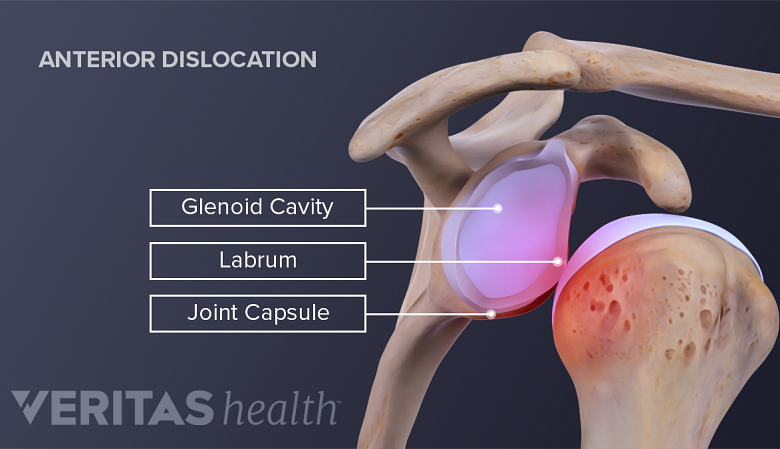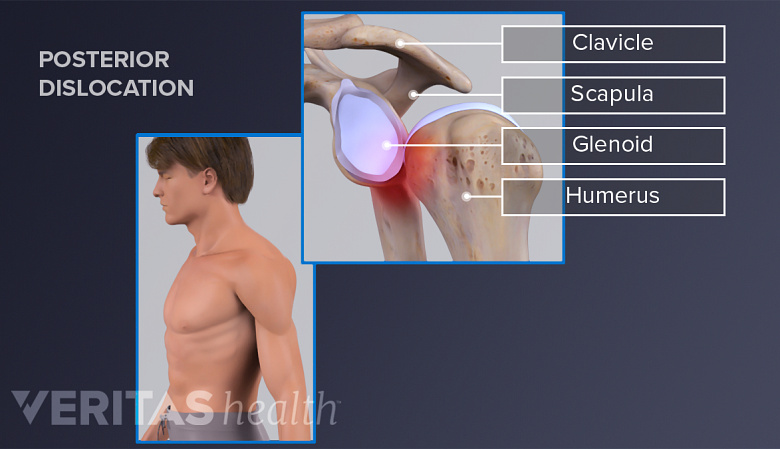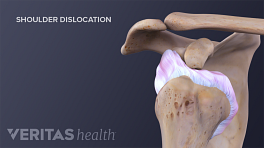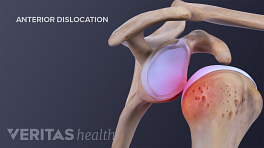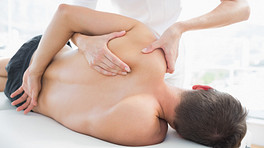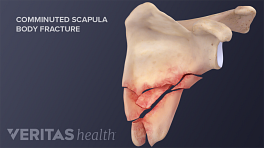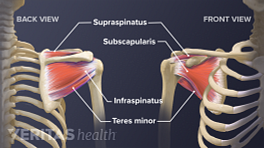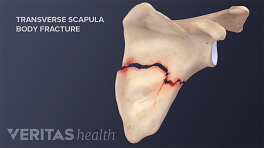Shoulder instability often stems from traumatic blows or aggressive motions that tear, stretch, or fray the ligaments and tendons around the joint. Loose shoulder joints also develop from genetic causes or growth abnormalities.
Instability occurs when the humerus (upper arm bone) loosens abnormally, either through partial slippage called subluxation or full detachment known as dislocation.
- Subluxations represent small but painful shifts as the upper arm bone edges towards a separation from its socket.
- Full dislocations constitute a complete structural failure as violent forces drive the head of the upper arm bone completely outside the shoulder’s socket cavity (glenoid fossa).
Following a shoulder subluxation or dislocation, the person instinctively splints the arm against the body to prevent the wrenching ache of the injury.
3 common causes of shoulder instability are described below.
In This Blog:
1. Traumatic injury
Dislocation can cause tears in the stabilizing capsule and ligaments of the shoulder.
Traumatic direct hits to the shoulder are a common cause of acute shoulder dislocations.
- Shoulder trauma from sports: Sudden impacts like tackling or being tackled in football, checking in hockey, or sliding in baseball potentially drive the upper arm bone forcefully out of alignment with the socket.
- Shoulder trauma from falls: Tripping, slipping, or forcefully falling onto an outstretched arm imparts rotational forces onto the shoulder joint, causing a displacement of the bones within the joint.
- Shoulder trauma from accidents or acute injury: Motor vehicle accidents result in aggressive shoulder dislocations as the body is thrown about. Even seemingly minor trauma, such as being pulled violently, can dislodge the loosely encased ball-and-socket joint.
Dislocation imparts tears to the capsule and ligaments that stabilize the shoulder as the arm is driven out from its stable position.
Traumatic shoulder instability is typically common in young athletes and men and accounts for more than 95% of all cases. 1 Varacallo M, Musto MA, Mair SD. Anterior Shoulder Instability. [Updated 2023 Aug 4]. In: StatPearls [Internet]. Treasure Island (FL): StatPearls Publishing; 2023 Jan-. Available from: https://www.ncbi.nlm.nih.gov/books/NBK538234/ , 2 Monk AP, Garfjeld Roberts P, Logishetty K, et al. Evidence in managing traumatic anterior shoulder instability: a scoping review. Br J Sports Med. 2015;49(5):307-311. doi:10.1136/bjsports-2013-092296
2. Overuse and repetitive microtrauma
Minor repetitive strains that develop over time progressively stretch the shoulder's stabilizers, such as ligaments and tendons.
- Overuse injury from sports: Swimmers, pitchers, and volleyball players perform thousands of overhead motions while participating in the respective sport, making the shoulder joint vulnerable to overuse injury.
The endless rotations slowly fray the joint’s labrum cartilage (that surrounds the glenoid cavity), capsule, ligaments, and rotator cuff tendons. - Overuse injury from work: Using an unsupported posture while lifting or carrying heavy loads overhead contributes to a risk of shoulder joint instability. Over time, muscular imbalances contribute by pulling the head of the upper arm bone out of alignment.
These insidious cases cause nagging discomfort and looseness before culminating in dislocation.
In some cases, the gradual degeneration of unstable shoulders causes the joint to dislocate suddenly with no major trauma.
3. Genetic causes and growth abnormalities
Genetic traits and developmental issues raise the risk of loose shoulder joints and potential dislocation.
- Connective tissue disorders such as Ehlers-Danlos syndrome cause hyperflexible and unstable ligaments. 3 Broida SE, Sweeney AP, Gottschalk MB, Wagner ER. Management of shoulder instability in hypermobility-type Ehlers-Danlos syndrome. JSES Reviews, Reports, and Techniques. 2021;1(3):155-164. doi:https://doi.org/10.1016/j.xrrt.2021.03.002
- Abnormal development (dysplasia) of the shoulder socket, including a shallow glenoid socket cavity or excessive roundness of the head of the upper arm bone, reduces the conformity of the shoulder joint.
- Childhood conditions such as growth plate injuries, fractures, or damage during childbirth also remodel growing bones into abnormal alignments. These congenital and developmental factors lead to inadequate joint containment, making dislocations likely with routine activities.
In severe cases, even gentle motions like lifting a bag trigger a dislocation. Atraumatic shoulder instability caused by genetic factors and growth abnormalities accounts for 2%-10% of all cases of shoulder instability. 4 Lebe M, Burns SA, Falworth M, Higgs DS, Rudge WB, Majed A. Atraumatic shoulder instability: patient characteristics, comorbidities, and disability. JSES Int. 2021;5(6):955-959. Published 2021 Sep 17. doi:10.1016/j.jseint.2021.08.001
Read: Guide to Shoulder Anatomy
How shoulder instability feels
A visible shoulder joint deformity or protrusion is observed in joint dislocation.
As the ball of the upper arm bone partially or completely dislocates from the shoulder’s socket, some combination of the following symptoms and signs may be experienced 5 Kuhn JE. A new classification system for shoulder instability. Br J Sports Med. 2010;44(5):341-346. doi:10.1136/bjsm.2009.071183 :
- Sudden, sharp pain
- Limited range of motion
- A sensation of looseness
- A sense of heaviness in the shoulder area
- A visible deformity or protrusion of the shoulder joint
- A lower or asymmetrical appearance compared to the uninjured side
- A feeling of weakness or inability to bear strength when lifting objects
During shoulder instability, the upper arm bone can be pushed in the forward (anterior shoulder instability), backward (posterior shoulder instability), or downward (inferior shoulder instability) directions.
After an initial event, repeated episodes of shoulder instability or dislocations are common.
See Dislocated Shoulder Symptoms
Differentiating between a dislocated shoulder and a fractured shoulder
Shoulder injuries often present with overlapping symptoms of pain, making it difficult to discern between common injuries like dislocation and fracture.
A fractured shoulder typically causes:
- Pain and tenderness concentrated around the site of the fracture
- Grating or crunching sound when trying to move the shoulder
- Bruising, swelling, and weakness in the upper arm
Carefully assessing the cause of injury and the key differentiating factors allows proper diagnosis and appropriate treatment.
Read about Shoulder Fractures
Voluntary shoulder dislocation
Voluntary shoulder dislocation is the rare ability to dislocate one’s own shoulder, taking advantage of inherent laxity in the capsule and ligaments.
Repeatedly forcing the shoulder out of its ball-and-socket joint stretches the labrum and further loosens the shoulder. If done repeatedly, the joint surfaces risk erosion, arthritis, and muscle atrophy.
Voluntary dislocation reflects true instability and warrants assessment and preventative care.
Next steps
If a dislocated shoulder is suspected, visiting the emergency room is advisable. Based on x-ray imaging, doctors realign the dislodged ball of the upper arm bone back into the shoulder socket cavity.
For individuals with high-demand lifestyles, such as athletes, repeat subluxations, dislocations, and failed joints sometimes require surgical intervention to reconstruct torn ligaments or augment loose joints.
- 1 Varacallo M, Musto MA, Mair SD. Anterior Shoulder Instability. [Updated 2023 Aug 4]. In: StatPearls [Internet]. Treasure Island (FL): StatPearls Publishing; 2023 Jan-. Available from: https://www.ncbi.nlm.nih.gov/books/NBK538234/
- 2 Monk AP, Garfjeld Roberts P, Logishetty K, et al. Evidence in managing traumatic anterior shoulder instability: a scoping review. Br J Sports Med. 2015;49(5):307-311. doi:10.1136/bjsports-2013-092296
- 3 Broida SE, Sweeney AP, Gottschalk MB, Wagner ER. Management of shoulder instability in hypermobility-type Ehlers-Danlos syndrome. JSES Reviews, Reports, and Techniques. 2021;1(3):155-164. doi:https://doi.org/10.1016/j.xrrt.2021.03.002
- 4 Lebe M, Burns SA, Falworth M, Higgs DS, Rudge WB, Majed A. Atraumatic shoulder instability: patient characteristics, comorbidities, and disability. JSES Int. 2021;5(6):955-959. Published 2021 Sep 17. doi:10.1016/j.jseint.2021.08.001
- 5 Kuhn JE. A new classification system for shoulder instability. Br J Sports Med. 2010;44(5):341-346. doi:10.1136/bjsm.2009.071183
